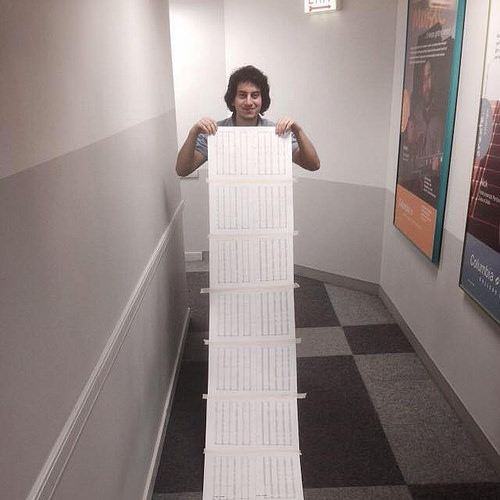
Recording Session Preparation

Score Prep
The first recording session of the semester is coming up very quick (20 piece ensemble, recorded at Chicago Recording Company): this Friday the 27th. After weeks of writing, producing, score preparation, and some conducting practice, we are feeling more prepared for the session. As this is our first time conducting and recording a group of professional musicians, this definitely will be a learning experience. Many in my class are very grateful to have observed the class of 2014’s recording sessions last year, soaking in the experience. We know the process, and how the studio is set up, and definitely remember how fast you must be. If you must make a comment, make it quick, and move on to the next take!
Class of 2014 Recording Session:
Over the last few weeks I’ve gotten quite a bit of advice and have been trying to prepare to make the session as smooth as possible. Here are a few tips I’ve put together.
Have other people look at your score and parts. It is often more difficult to see errors in your work. This is probably because you are so used to seeing the mistakes, fresh eyes will usually see the errors much quicker. Also, make sure to print out your score and parts while proofreading. This will make it very easy to mark errors, and you can more easily mark mistakes than on a computer.
Be bold when writing dynamics and don’t write divisi with a small ensemble. Writing mp to mf is not a great dynamic change, writing p to f instead will give you a much more obvious change. When using a string section below twenty players, using divisi might not be the best use of the musicians. The string ensemble sound starts to disappear, leaving you with many individual solo lines.
Make sure your Protools session is simple, but has everything the musicians might need. Nothing would be more frustrating than to have your recording session cut in half due to the tempo click track. If you want the musicians to hear an important synth or piano prelay, make sure to have those on an individual track.
Know every entrance, and every phrase without looking at the score. If you are prepared, cueing in musicians shouldn’t be much of a problem. Then you can focus on phrasing, and overall emotional vibes of the piece.
You’re not done yet! Mixing the recording with your electronics and sampler prelays, editing the takes together, and properly blending the two together are also very important. Often times, multiple takes of strings are layered together to create a much larger sounding group. This takes patience and an ear for detail, editing starts and ends, and exaggerating dynamics with the fader. The recordings can bring liveliness to the piece, but unedited can sometimes sound flat and hollow. Make sure you spend some time in Protools to get the mix working.
